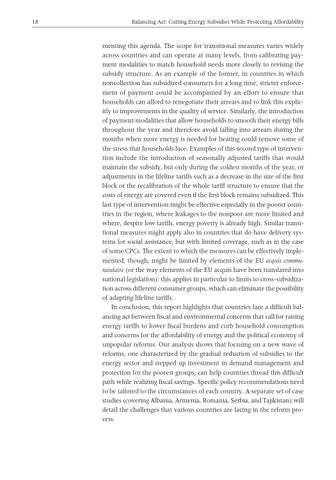18
Balancing Act: Cutting Energy Subsidies While Protecting Affordability
menting this agenda. The scope for transitional measures varies widely across countries and can operate at many levels, from calibrating payment modalities to match household needs more closely to revising the subsidy structure. As an example of the former, in countries in which noncollection has subsidized consumers for a long time, stricter enforcement of payment could be accompanied by an effort to ensure that households can afford to renegotiate their arrears and to link this explicitly to improvements in the quality of service. Similarly, the introduction of payment modalities that allow households to smooth their energy bills throughout the year and therefore avoid falling into arrears during the months when more energy is needed for heating could remove some of the stress that households face. Examples of this second type of intervention include the introduction of seasonally adjusted tariffs that would maintain the subsidy, but only during the coldest months of the year, or adjustments in the lifeline tariffs such as a decrease in the size of the first block or the recalibration of the whole tariff structure to ensure that the costs of energy are covered even if the first block remains subsidized. This last type of intervention might be effective especially in the poorer countries in the region, where leakages to the nonpoor are more limited and where, despite low tariffs, energy poverty is already high. Similar transitional measures might apply also in countries that do have delivery systems for social assistance, but with limited coverage, such as in the case of some CPCs. The extent to which the measures can be effectively implemented, though, might be limited by elements of the EU acquis communautaire (or the way elements of the EU acquis have been translated into national legislation): this applies in particular to limits to cross-subsidization across different consumer groups, which can eliminate the possibility of adapting lifeline tariffs. In conclusion, this report highlights that countries face a difficult balancing act between fiscal and environmental concerns that call for raising energy tariffs to lower fiscal burdens and curb household consumption and concerns for the affordability of energy and the political economy of unpopular reforms. Our analysis shows that focusing on a new wave of reforms, one characterized by the gradual reduction of subsidies to the energy sector and stepped up investment in demand management and protection for the poorest groups, can help countries thread this difficult path while realizing fiscal savings. Specific policy recommendations need to be tailored to the circumstances of each country. A separate set of case studies (covering Albania, Armenia, Romania, Serbia, and Tajikistan) will detail the challenges that various countries are facing in the reform process.
